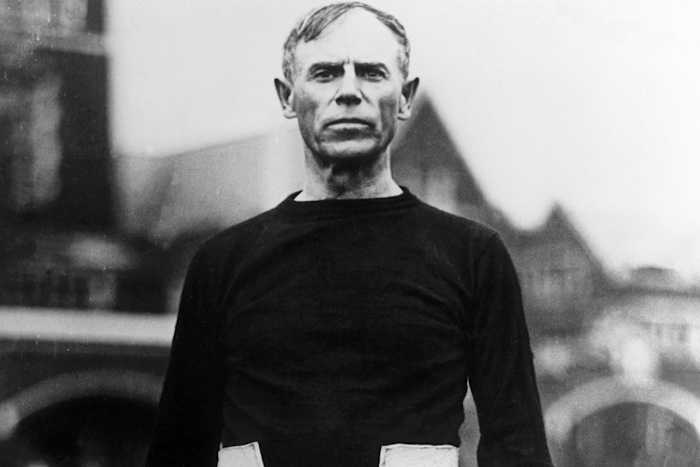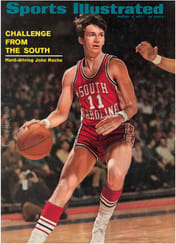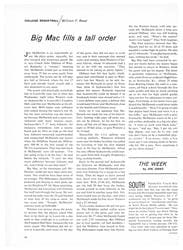Heisman Trophy or Bogart Cup?
By the end of each year sports fans everywhere know who won the Davis Cup, the Stanley Cup, the Curtis Cup and a host of other trophies. But what do they know about the people whose names are on the cups? About Dwight F. Davis? About Lord Stanley? About Margaret and Harriot Curtis? Little enough, in all likelihood. All of us learned a few weeks ago that Jim Plunkett, the Stanford quarterback, had just won the Heisman Trophy for 1970. We know quite a bit about Plunkett—but what do we know about Heisman? Probably about as much as the man who in 1948, some 13 years after the trophy was instituted, introduced that year's selectee, Southern Methodist's fabulous Doak Walker as "the great Wassermann winner."
Even the record books haven't got things quite straight about the man they list as John William Heisman. In the first place, he was not John William, but Johann Wilhelm. In the second, even his claim to the surname Heisman was questionable. His great-grandfather was a German baron named von Bogart whose willful son married a peasant girl from Alsace-Lorraine and was promptly disinherited. Rather than give up his bride, the stubborn son gave up his name, took hers (Heismann) and fled to the U.S., where he struck it rich in the oil-barrel business in Pennsylvania. Although the old baron, by then fallen on hard times, eventually proved willing to overlook the defections of a son so obviously solvent, and offered him the comfort of his home and his name again, the son decided to stay where he was and stick to the new monicker. Thus it was that the son born to his son in Cleveland in 1870 bore the name Heismann or Heisman rather than Bogart; otherwise everyone might be guessing at year's end who would win the Bogart Trophy.
Whatever his proper surname, Johann Wilhelm was an avid athlete. He played baseball, ran track, and was one of the first football players to earn letters at two colleges. He played tackle for Brown for three years, then moved on to Penn to play tackle and end and pick up an LL.B. degree.
Even after graduation, football continued to have a greater appeal to Johann than the law, and he went on to win a place in Football's Hall of Fame as one of the game's most successful coaches and innovators. As a coach at eight colleges—Oberlin, Akron, Auburn, Clemson, Georgia Tech, Penn, Washington & Jefferson and Rice—Heisman had a record of 186 wins against only 70 losses. As an innovator, he devised the center snap, the first legitimate scoreboard and was responsible for the ultimate legalization and recognition of the forward pass.
In 1895 Heisman had seen what was probably the first forward pass in football history, a last-ditch bit of inventiveness by a North Carolina punter who eluded onrushing Georgia tacklers by throwing, rather than kicking, the ball for a game-winning 70-yard touchdown. Heisman, already disenchanted with the old game's brutality—its flying wedges, mass formations, and bloodied players—saw in this gesture a whole new vision of football, gentled and made exquisite by the forward pass, and he determined one day to make it a basic part of the game.
Long before he was able to accomplish this, however, Coach Heisman kept busy winning games the old way. By the time his forward pass came into general use Heisman was starting the third of his 16 successful seasons at Georgia Tech. His 1899 Auburn team had beaten Tech 63-0 and four years later his Clemson club had embarrassed the Rambling Wrecks 73-0. Obviously there was nothing Tech could do but hire him, and in 1916 Heisman's Tech team ran up the highest score of all time, beating Cumberland College in Lebanon, Tenn., by a score of 222-0.
As a coach, Johann Wilhelm had more than a trace of his German great-grandfather's aristocratic mien (a coach, he insisted, "should be masterful and commanding, even dictatorial; he must be severe, arbitrary and little short of a czar") spiced with a generous helping of pure Westphalian ham.
"No apples, no apples," he would declaim at the training table. "Give my players raw meat. Lots of raw meat." Once at the college chapel services he rose to say, "Gentlemen, we are destitute of people. If you weigh 150 pounds or more, please come out for football."
Each fall as the football season began, Coach Heisman would face his recruits holding a football as Hamlet held Yorick's skull. "What is it?" he would ask rhetorically. "A prolate spheroid, an elongated sphere—in which the outer leathern casing is drawn tightly over a somewhat smaller rubber tubing." Then, after a melodramatic pause, he would say in muted tones, "Better to have died as a small boy than to fumble this football."
Heisman's stepson, Carlisle Cox, a retired cavalry colonel, recalled in the December 1964 issue of Atlanta magazine how Heisman used to pace the floor of his study "and talk out his problems aloud.... In this room there was a chandelier which hung just low enough to hit his bald spot. He would walk under that chandelier, it would clip him, he would cuss a little, move off to one side and four minutes later he would walk under it and bust his head again. For one entire season his head never got well."
Early in his career such total preoccupation with the game he loved cost Heisman his job and led to his becoming, in all likelihood, the first coach to be fired for the sake of de-emphasis. In 1893 Heisman had been hired as athletic director of Buchtel College (now the University of Akron) soon after the Ohio Intercollegiate Athletic Association insisted that football be added to baseball, track and debating as grounds for membership. Heisman succeeded so well in instilling the boys of Buchtel with the desire to win that he was fired a year later. "For some time," as a local historian put it, "there had been a growing feeling of protest in the faculty" which felt the main objective of football "should not be to win...but to minister to the physical development of those engaged in this exercise."
Before going back to his old job at Oberlin, the fired athletic director decided to stay just long enough to give Buchtel's faculty a contest it would remember for all time: a final do-or-die football game between Buchtel and Ohio State, to be staged as part of a triple-header designed to lure football fans to the Ohio State Fair in Columbus.
While at Oberlin, Heisman had twice whipped the Buckeyes 40-0 and then 50-0. But the next year, at Buchtel, he had lost to Ohio State 32-18. Whatever his motive, Heisman convinced himself and his players to get off to a training camp at a lake just outside of Akron, where for two weeks they all took part in a rugged conditioning program. They needed it badly.
As one player explained: "It was the fashion then for the man with the ball to keep on crawling as long as he could with 21 men, more or less, on top of him. The ball was not 'down' so long as the player was in motion. The only effective way to stop a man crawling was to jump on the fellow's head and ram his face into the ground."
Robert Osburne, Buchtel's left tackle, wrote in 1919: "Massed plays were in vogue and when 22 men came together after a five-or ten-yard start, in a double-V formation, something happened to the men in the front lines.... A man could not be taken out unless he had received sufficient damage to disable him.... Broken arms, legs, noses, shoulders, ribs, etc. were in the inventory of the game."
With such a fearful encounter in the offing Heisman enlisted a few ringers for his team, several of whom came from Oberlin. The outstanding ringer, though, was Heisman himself, who quarter-backed the squad. (Ohio State, it turned out, also fleshed out its ranks with a few outsiders.)
Unfortunately, the citizens of Akron hardly shared Heisman's enthusiasm for the forthcoming struggle. The Akron Beacon and Republican made no mention of the game. Its pages were chock full of gossip about W. K. Vanderbilt's difficulties with "the gay Parisienne Nellie Neustedter" and assurances that there was "No danger of sewer gas in Cahoon's ice cream, as it is not manufactured or stored in a basement," but not a word about football.
Players from both Ohio State and Buchtel would have given anything for some of Cahoon's ice cream as they played amid clouds of dust in noonday heat on a field surrounded by a racetrack. At the end of the first 20-minute half the score was 6-6, each team having scored a four-point touchdown and kicked a two-point conversion.
Years later Heisman recalled the game like this: "All the players of both teams were half dead before the first half was over.... Frank Fisher had the 'sun staggers'...and could no longer see.... When time was up Frank found himself slowly improving, but was still unable to visualize objects clearly, and I was in a quandary. But just then the OSU captain came up and wanted to know if we wouldn't let him have a few minutes more time. He said his men were all used up and overcome with the heat, and he was afraid some players of either side might get a sunstroke if we continued immediately. I assured him that was my fear exactly....
"Well, in about 10 minutes more we were both ready to resume hostilities. And then we seesawed back and forth another 20 minutes without either team scoring.... One time we had the ball on their two-yard line, and then I had to make the only fumble we had all day."
When the game ended the score was still 6-6, so it was agreed to play a sudden-death overtime of a maximum of 10 minutes. Ohio State worked the ball almost to midfield before relinquishing it.
Recalling those closing minutes, Heisman wrote: "Working mostly off-tackle smashes...we gained seldom less than three yards; and in those days we had only to make five yards in three trials. All the time I was saving Fisher...because he was still 'seeing things,' though continually getting better, and besides I wanted to have one fresh man when we got down near the promised land."
Less than four yards from the Buckeye goal line, Heisman, that inveterate ham, saw both "the promised land" and a perfect spot for a sample of his histrionics. "I deliberately stopped," he says, "and made our men a little talk, reciting that we had been down there once before and that I myself had thrown our chance away by a rotten fumble, but that this time we were going over, if only everybody would get into this one play. So said they all, and I called for Frank to buck through their right tackle.
"I got hold of the ball safely and stuck it squarely into his breadbasket. Fortunately he either saw or felt it—and got it. Then away we all went like mad. I think about every man on the team had his hands on Frank somewhere, for that was in the days when hiking the runner, pushing, pulling or even throwing him, was the big thing in the game. I recall I had hold of him by the back of his jersey and was going in front of him. And we all went through together, just like the water of a milldam when the dam goes out. With a last yank I tore the jersey clear off Frank's back. But what did it matter since we were across?"
When Heisman's coaching days ended in 1927 he moved to New York City and became athletic director at the Downtown Athletic Club. It was that organization, a year before his death, that decided to perpetuate his name, if not precisely his memory: in a suitable award to be known as the Heisman Trophy, a trophy decorated with the figure of a man clutching a prolate spheroid as if he would rather have died as a small boy than now to fumble it.
PHOTO
JOHANN WILHELM HEISMANN AS A QUAKER


